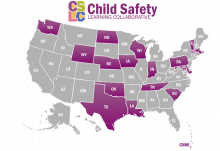CSN Webinars
![]() This page displays all Children’s Safety Network’s (CSN) archived webinars. You may view the archived recordings or PowerPoint presentations as PDFs. For information or to register for upcoming events and webinars, see our Events.
This page displays all Children’s Safety Network’s (CSN) archived webinars. You may view the archived recordings or PowerPoint presentations as PDFs. For information or to register for upcoming events and webinars, see our Events.
State Technical Assistance Webinar 8 - July 2020: Child and Adolescent Injury and Violence Prevention During COVID-19 - Jul 2020
On our July 16th STAW, we discussed the importance of quality improvement in times of crisis, and how MCH/IVP programs can pivot their messaging, communication strategies, or structure during these uncertain times of COVID-19. We were happy to welcome the following presenters join us:…
Play it Safe: Playground Safety for Everyone - May 2020
Play it Safe: Playground Safety for Everyone - May 2020
Playgrounds serve as a central hub for communities, yet playground-related injuries remain a concern among parents, educators and health care providers. More than 200,000 playground-related injuries are treated in the U.S. emergency departments annually among children 18 years and younger.1 The…
Highlights from the Child Safety Learning Collaborative - May 2020
The Children’s Safety Network (CSN) strives to reduce injury and violence related fatalities, hospitalizations, and emergency department visits among infants, children, and adolescents, ages 0-19, through capacity building in injury and violence prevention with state and jurisdiction Title V…
State Technical Assistance Webinar 7, April 16, 2020: Applying a Health Equity Lens to Child Safety - Apr 2020
State Technical Assistance Webinar 7, April 16, 2020: Applying a Health Equity Lens to Child Safety - Apr 2020
The April 2020 State Technical Assistance Webinar (STAW) was be on “Applying a Health Equity Lens to Child Safety.” Description: Health inequities exist and are reflected in differences in length and quality of life, as well as the rates and severity of injuries. The Children’s Safety Network is…
Evidence-Based/Informed Interventions and How They Can Improve Our Work - Apr 2020
Evidence-based programs are those that have been rigorously tested in controlled settings, proven effective, and translated into practical models that are widely available. Evidence-informed programs, or practice-based evidence, uses the best available information, research and practice…
State Technical Assistance Webinar 6 - February 20, 2020: Social and Emotional Learning and Mental Health: An Integrated Approach to Promote Child and Adolescent Wellbeing - Feb 2020
Social and Emotional Learning and Mental Health: An Integrated Approach to Promote Child and Adolescent Wellbeing Thursday, February 20, 2020, 1:00 – 2:30 PM ET. A growing body of research shows that proactive support of young people’s social emotional development and mental health…
State Technical Assistance Webinar 5 - December 2019: How to Use Data in Child and Adolescent Injury and Violence Prevention - Dec 2019
The last State Technical Assistance Webinar (STAW) of 2019 took place on December 19 from 1:00-2:30 PM ET. During this STAW Bina Ali, a research scientist at PIRE and director of the Children’s Safety Network Economics and Data Analysis Resource Center (CSN EDARC), presented information pertinent…
Understanding and Preventing Electronic Cigarette Use Among Youth - Dec 2019
Electronic cigarettes (“e-cigarettes,” “e-cigs,” “vapes,” “e-hookahs,” “vape pens,” and “electronic nicotine delivery systems (ENDS),” are experiencing widespread use among American youth. E-cigarette poisonings among children and youth are a concern for health care providers, parents, poison…
Keeping Kids and Families Safe Throughout the Holidays - Dec 2019
Toy safety is a year round concern, but is heightened during the holidays. While the holidays are a time of joy and celebration for many, unfortunately, toy and holiday decorating injuries and deaths are all too frequent. In 2017, according to the Consumer Product Safety Commission (CPSC…
State Technical Assistance Webinar 4 - August 2019: Incorporating Youth Voice into Child and Adolescent Injury and Violence Prevention - Aug 2019
Webinar: Incorporating Youth Voice into Child and Adolescent Injury and Violence Prevention Recorded on August 15, 2019, 1:00 – 2:30 PM ET This Children's Safety Network (CSN) State Technical Assistance Webinar (STAW) focused on the power of incorporating youth voice…
Screening Youth for Suicide Risk - Jul 2019
Screening Youth for Suicide Risk - Jul 2019
The suicide rate among U.S. youth and young adults, ages 10 to 24, has risen in recent years, increasing by nearly 50 percent between 2007 and 2017, and reaching its highest point since 2000 according to the US Centers for Disease Control and Prevention. In 2017, 6769 suicides occurred among…
State Technical Assistance Webinar 3 - June 2019: Maintaining and Nourishing Partners - Jun 2019
Thank you for joining us for a very engaging State Technical Assistance Webinar (STAW) on June 20th. As your work continues to evolve, it’s good practice to revisit your partnerships not only to see who else you should invite to work with you but also to see how you can improve already established…
Protecting Child Passengers, Now and Into the Future - May 2019
The first law protecting child passengers in motor vehicles was passed by Tennessee 41 years ago. Since that time, much has been learned about best practices and countermeasures that work to reduce death and injury among children on our roadways. While legislation, education, enforcement and…
Infant Safe Sleep: An Introduction and Model Program - May 2019
Sudden unexpected infant death (SUID) occurs among approximately 3,500 babies in the US each year. SUID, the sudden and unexpected death of a baby less than 1 year old in which the cause was not obvious before investigation, includes sudden infant death syndrome (SIDS), accidental suffocation…
State Technical Assistance Webinar 2, April 18, 2019: Effective Communication Strategies, Formal Partnerships, and Leadership Engagement - Apr 2019
Thank you for joining us on our State Technical Assistance Webinar (STAW) on April 18, 2019 from 1:00 – 2:30 PM. The STAW was an interactive discussion focused on effective communication strategies, formal partnerships, and leadership engagement at all levels. We heard from two guest speakers…
Traumatic Brain Injury among Children and Youth: Understanding TBI and One Model State Program - Feb 2019
Traumatic Brain Injury among Children and Youth: Understanding TBI and One Model State Program - Feb 2019
Reports of traumatic brain injuries (TBIs) among adults, particularly in professional sports, are often in the news. But what about TBIs among children and youth? In 2012, an estimated 329,290 children (age 19 or younger) were treated in emergency departments (EDs) for sports and recreation-…
State Technical Assistance Webinar 1, January 17, 2019: Improving your Injury and Violence Prevention System: Connecting Programs, Processes, People and Data - Jan 2019
The STAWs are intended for a limited audience that includes all S/J level Title V agencies, including MCH and IVP Directors. Participating states and jurisdictions of the Child Safety Learning Collaborative are required to attend. Thank you for joining us on our State Technical Assistance Webinar (…
"Synthetic Marijuana:" What Is It, Why Is It Dangerous, and How Can We Prevent Youth from Using It? - Nov 2018
"Synthetic Marijuana:" What Is It, Why Is It Dangerous, and How Can We Prevent Youth from Using It? - Nov 2018
Synthetic cannabinoids, misleadingly called “synthetic marijuana” are human-made mind-altering chemicals that are either sprayed on dried, shredded plant material so they can be smoked or sold as liquids to be vaporized and inhaled in e-cigarettes and other devices. (1) Also known as “K2,” “…
Working “Upstream” to Prevent Adverse Childhood Experiences (ACEs) - Sep 2018
Professionals in many fields are working to address the effects of adverse childhood experiences (ACEs), which have been shown to increase risk for a wide range of problems. One of these adverse experiences is child abuse and/or neglect, which the Centers for Disease Control and Prevention (CDC)…
How Social and Emotional Learning (SEL) Can Help Prevent Bullying - Aug 2018
This interactive webinar focused on the latest research on bullying among children and adolescents and explored strategies for using social and emotional learning (SEL) to prevent bullying. Social and emotional learning helps children and adolescents to manage their emotions, empathize with others…












